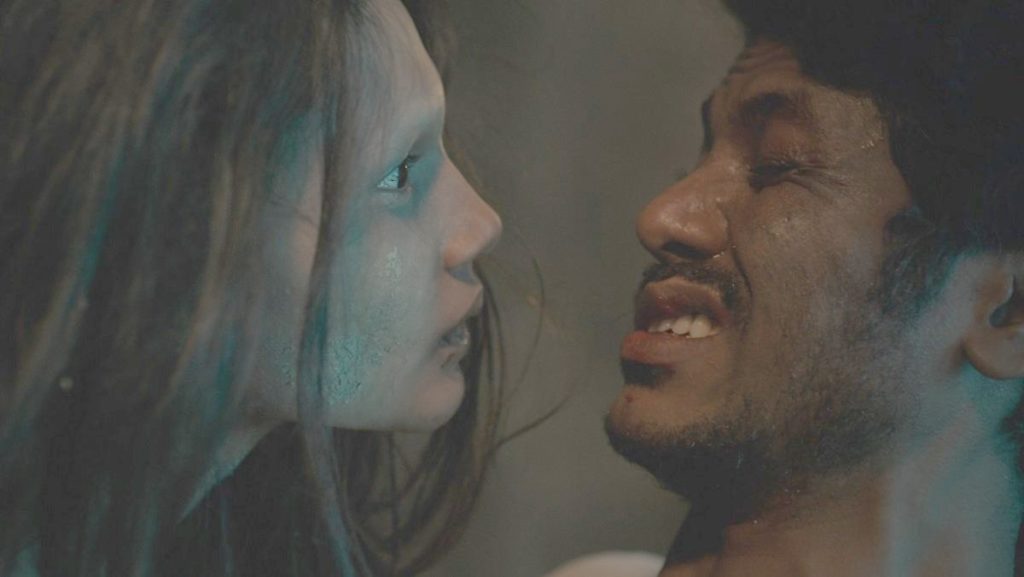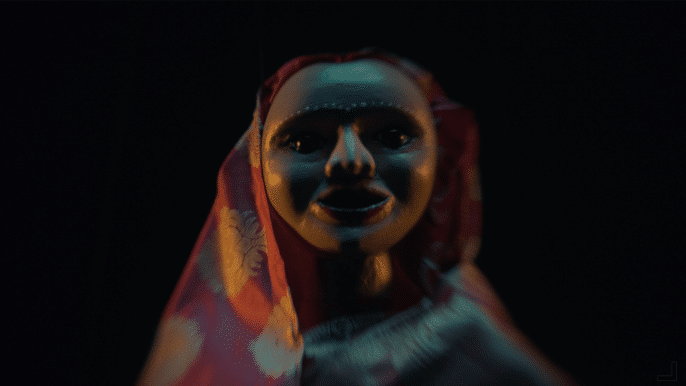
Bangladeshi horror cinema is all but unknown to me, so the chance to see a Bangladeshi anthology film was too good to pass up. Pett Kata Shaw (2023) contains four distinct stories – in fact, these are compiled together here after a four-part TV series, meaning there isn’t really an overarching framing narrative, and as such the stories are united only by their shared topic: the presence of folklore in modern urban life and the urbanites who encounter that folklore. The result is a rather disparate, but still engaging bundle of tales, always beautifully shot, lit and colourised, and able to bring something fresh to a foreign viewer like myself (even whilst making clear that folk stories around the world have a lot more elements in common than wholly different).
The first story perhaps feels the most familiar, for the simple fact that Islamic beliefs overlap to a large extent with Christian ones; they’re both monotheistic faiths, and both share large swathes of their origin stories. A sweet shop owner is sweeping his premises after hours, when he hears a mysterious knock on the shutters outside. He looks, but there’s nothing there; he must’ve mentioned this to his wife when getting home, as she makes the link between sweet shops and djinn (spirits, or sometimes demons in Islamic and Arabic tradition – perhaps best known to Westerners in the Anglicised form of ‘genie’). Mischievous spirits with a liking for sugar? As strange as that sounds, the next night, the unexplained phenomena happen again, this time heralding the arrival of a strange, lame man, asking for sweets. The shopkeeper (Chanchal Chowdhury) obliges: how could he not? And by the way – there’s no ambiguity here about whether or not this is just a normal, if opening hours-averse old man, and his supernatural abilities are evident from the off.
Transaction done, the djinn – let’s just call him that – offers payment. Here’s where the djnn is most recognisable to us (assuming you’re reading in Europe, Australia or America) as a deal-doer, trading something remarkable, like magic wishes, but doing so in a very strings-attached way. It’s soon clear what our shopkeeper has asked as payment – this forgetful, careless man suddenly develops a new, incredibly sharp persona – but, as usual, it comes at a steep price. As much as he dabbles with Islamic prayers of protection and the whole segment is pinned around Arabic folkloric beliefs, it’s a recognisable devil’s bargain of sorts and as such, a cautionary tale soon comes into view. It’s a simple enough story as all of the takes in Pett Kata Shaw are, but it is reasonably paced and well acted.
Next up (and you’ll have to excuse the lack of chapter titles, as these weren’t translated on my screener) a young man tells the story of a bizarre trip to the local fish market – yes, a fish market – and what happens to him next. He, as one of two bachelors living together in an apartment, has some strict rules to live by when it comes to female guests – but nonetheless, someone or something seemingly female follows him home, determined to get a good meal out of him, it seems. There’s some humour and some self-deprecation here, though to make these moments land depends on a lot of exposition being readily offered in the lead character’s monologue; a lot hinges on his proffered family memories, particularly of his mother, and how she raised him to be able to deal with a crisis. Well, this is a crisis, as the fish-loving entity now in his sitting room is a dangerous and irrational presence. A little thin story-wise, there are still some enjoyable ‘ick’ moments.
The third chapter is the one I personally find the strongest, coming as it does with the most layering and symbolism of all the stories; as it unfolds, it’s able to raise some tantalising, visually-rich ideas about the role of storytelling, its origins, and its relationship to the often brutal, unpleasant facts which give rise to its currents of escapism and lesson-learning. A miserable couple are hiking in a rural part of the country (and they were, we glean, miserable before; the hike itself isn’t the problem). When the girlfriend spots a suspicious text message coming in on her boyfriend’s phone, it’s the culmination of a long-brewing argument. But they’re lost, and they have to stop off at a nearby village for help.
The residents there are friendly enough, though you’d surely get a sinking feeling from their revelation that ‘no tourists ever visit here, only lost travellers’. It gets heavier, as some of the elderly folk there explain that this village is the source for all of the country’s folklore. All of it. All of its sayings, its folk wisdom? From right here. It seems incredible, but they begin unfolding stories which they can link to well-known Bangladeshi sayings, except their versions always cling harder to violence, weirdness and trauma; it’s just that these darker elements have eventually given way to easily-remembered, if unaccountable aphorisms. This chapter in the film adds a further level of the uncanny by introducing a series of puppets to enact some moments of their tales; it starts off a little queasily weird, but given some time, the puppet show really works – it captures something of that real-unreal nature of folk tales. Furthermore, this chapter holds back a deeply unsettling finale which brings us full circle, maybe to another folk tale for the future. Stories, after all, keep on emerging.
The final chapter – and I can’t help but think that three chapters would have been better, if only in terms of genre expectations (it’s just so often three tales!) and the film’s overall runtime, which gets to 110 minutes off the back of this last, thirty-minute story – does more layering of tale within tale which – if this film has a uniting motif – is this type of Russian doll narrative structure. This time, we are introduced to the folklore of the sea and the ‘Nishi Daak’ – a spirit which impersonates people known to its victims, trying to drown them (and it seems every culture with a coastline has something similar to this). But not only does this entity speak to the most vulnerable, such as the street children whose piecemeal existence leads them to crave the representations of lost parents who call to them, but to adults, too. Rabab is a successful young filmmaker who has moved away from his place of origin, but a visit back to an old haunt is overshadowed by a recent loss: his former girlfriend, ominously named Lamia, who took her own life.
He begins with a professional curiosity about the fates of so many missing children on this beach, but Rabab is torn between his guilt at moving on with his life perhaps rather too readily, and the folklore of the region which now also seems to be enticing him to leave his new, successful, urbanite life behind for good. The chapter feels like the most obviously horror-influenced, Western-influenced part, despite the presence of a distinctly regional supernatural element, simply through its use of technology, YouTube, social media – and code switching, with Americanised English creeping in here and there. However, for all that (or perhaps because of that) it can feel derivative, even though some of the scenes here are very effective indeed.
Whilst one proffered link between all the chapters at the end really isn’t enough to provide a sense that these tales are related to one another, they still nonetheless capture the imagination pretty effectively, and they’re intriguing on the whole. The horror in each chapter comes from quite basic, everyday situations – a day at work, a trip to the market, a walk in the country – but successfully blend in uncanny elements which both showcase Bangladeshi folk belief and echo many commonly-held Western beliefs, because after all (and as the point is made in the third chapter) stories often start life as cautionary, associating entities with dangerous locations or foolhardy actions because people seem so hardwired to respond to anecdotes, rather than facts and statistics. Each chapter is also effective at presenting stories-within-stories, which is the way stories are, so rarely ending neatly or with an agreed-upon resolution. It would seem likely that many of the supernatural beliefs explored in Pett Kata Shaw would be as unfamiliar to younger Bangladeshi audiences as to foreign audiences, for the very reason that urban myths have often updated and replaced older stories as we’ve moved to, or been born in cities, but certainly the series and now, the film, would be an agreeable and stylish introduction, or reminder. The horror itself isn’t always necessarily highly original or unsettling – there are flaws in tone and length – but these are overall engaging tales with enough dashes of anxieties over class, gender, wealth and character to give them a wider appeal.
Pett Kata Shaw will receive its UK premiere at the Raindance Film Festival 2023 on 31st October.
